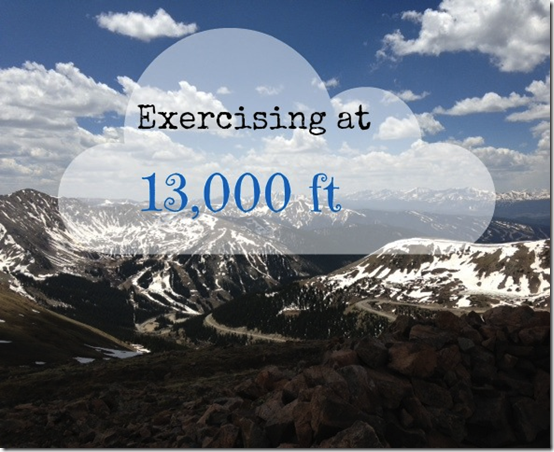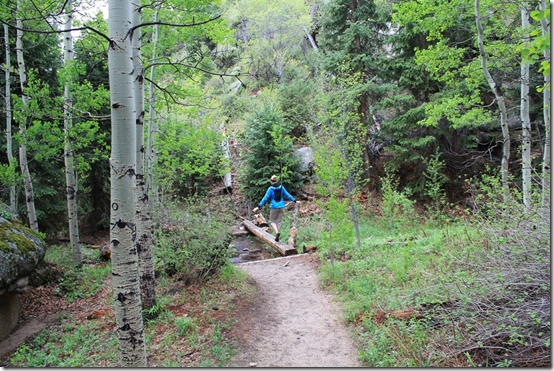Some thoughts and discussions from me.
Morning ![]()
Yesterday in between clients, I had an hour to get my own workout in. I had a yoga class on tap later, but wanted to make the most of my time with a full body workout, too. Another Soldier of Steel workout!
RUN 10 MIN AT EASY PACE
3x 5 WALL SQUAT
3x 20 AIR SQUAT
3x 10 JUMP SQUAT
3x 20 WALKING LUNGE
4x 30/30 FROG HOP
REST 2 MIN
4x 30/30 SPLIT JUMP
REST 2 MIN
4x 30/30 BURPEE
COOL DOWN WITH 10 MIN RUN/WALK AT EASY PACE
Wall squats? Much tougher than they look. And I’m not sure why in heck I picked another workout with burpees in it ![]() Got my HR up! The rest of the week is going to be a little more recovery-focused.
Got my HR up! The rest of the week is going to be a little more recovery-focused.
And speaking of getting heart rates up, let’s go back to that hike I told you guys about that I did on Saturday. Remember how I said the entire way up was like a High Intensity Interval Training workout? Sure, part of the reason is because it’s a pretty steep incline. But for the most part there’s one component that made my heart work so hard to pump that oxygen to my working muscles: the altitude!
Exercising at high altitudes can be very frustrating – and tricky. We know we’re in shape, we know what we can do, but for some reason when we’re in the mountains, it makes it MUCH more difficult. We have to breath heavier and more frequently. This is because there’s less oxygen in our blood, we have a lower amount of blood pumped by our hearts per beat. Not to mention, we lose fluids more easily, and our metabolism and resting heart rate is increased.
But first, let’s clear something up: there is NOT less oxygen in the air at the summit of Loveland Pass than there is in Miami Beach, Florida. The air has the same amount of atmosphere no matter the location (about 21%,) but there’s less pressure surrounding that air, which equates to our lungs breathing in less atmosphere. Then because there’s less oxygen in our blood, it does a poorer job of oxygenating our muscles. Thusly, we get lead legs. Make sense?
Here’s a surprising fact: Fitter people (those who have a higher VO2 max) actually have a harder time exercising at high altitudes than less fit people! It has to do with VO2 max – those with a high VO2max have more oxygen in the blood to lose, and thusly feel the effects more than those with lower VO2 max.
Acclimating to Exercise at Altitude
(as always, check with a doctor before beginning any new exercise or activity/program!)
-
Reduce the intensity at first – don’t go on the biggest hike of your trip on the first day (like we did last year, haha)
-
Take frequent breaks – or hike/run/perform in intervals. it’s much easier for our bodies to do anaerobic exercise at altitude, so taking frequent breaks will allow you to build back up the energy for the next “sprint.”
-
Drink more water – since we have to breathe more frequently, we’re breathing out fluid much more frequently, too. Keep hydrated to prevent altitude sickness!
-
Eat some carbs – in an anaerobic state, our bodies rely on glycogen (carbs) for energy. If you’re not eating many carbohydrates, it may be a good idea to eat a few more for fuel.
Happy mountain-ing ![]()
Have you ever been surprised at the difficulty of moving/exercising at altitude?
Have you ever experienced altitude sickness or Acute Mountain Sickness?





I have never really exercised at higher altitudes. I did run a half marathon in the mountains once but I was okay, however it was also at the base and probably not too much different than my usual altitude where I live only 2 hours away.
Good to know this though!
Lindsey recently posted…Playing Catch Up
I can’t wait to get to the CO mountains some day. They’re stunning.
Lindsay recently posted…thursday thanks — blogger shout out.
Definitely something to keep in mind when I eventually find myself hiking in the mountains! I haven’t one it before, but it’s definitely on the bucket list.
Sam @ Better With Sprinkles recently posted…Slow Cooker BBQ Baked Beans.
I’ve never experienced this but I can imagine it’s a lot harder than it seems! It’s a good thing I have no cardio capacity then – I’d make it up there just fine 😉
I’ve never experienced major effects of altitude change I don’t think. The hike we did in the Blue Ridge mountains was close to 2500 feet elevation, but I don’t think it was enough to really notice. Sounds super tough though!
Kacy recently posted…Mini hike @ Scott’s Run
My husband and I traveled to Denver last July, and we definitely noticed the altitude change. We were there for less than a week and did a lot of hiking and walking around, so I didn’t plan any official workouts, but it was frustrating to be short of breath doing things that would usually not be a issue (like walking up a few slights of stairs.) Funny story: after riding the cog train to the top of Pike’s Peak, we bought one of their high altitude doughnuts that they sell at the top. The air was so thin that I was almost gasping for air between bites of the doughnut. I thought, “Man… this is really a low point for me. I am winded eating a doughnut!” 😀
Catherine @ A Two Storey Home recently posted…Jillian Michaels and Fresh Green Beans
Well, I LOVE your research here! Very interesting facts!
I had my VO2max tested and it was off the charts high (I don’t know if years of being a Spinning instructor has anything to do with that). And the altitude KICKS MY BUTT up at Loveland Pass! Umm… maybe our husbands are less fit than their wives….?
Lauren @ Oatmeal after Spinning recently posted…High Protein Pancakes [FlapJacked Review!]
That’s what I’m going with 😉 haha
and I told you I was nerdy with this stuff! Plus, it was fresh in my mind with my recent exam 🙂 – with a little refresher
I used to get severe altitude sickness when I was younger, but it seems to have dissipated as an adult. As much as I go to Colorado, I’m still amazed by how much I underestimate it. The heart pounding and lead legs are definitely things I can relate to!
Natalie @ Free Range Human recently posted…Heartbroken
i’ve also been told (although, no idea if it’s legit or not!) that drinking water helps because it helps replace the lost oxygen.
lynne @ lgsmash recently posted…Crafterday: Make A Mustache Mirror!